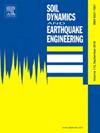Cyclic shear stress reduction ratio evaluation for liquefiable ground treated by in-ground structural walls
IF 4.2
2区 工程技术
Q1 ENGINEERING, GEOLOGICAL
引用次数: 0
Abstract
Soil liquefaction during seismic events may pose significant risks to the stability of buildings and infrastructure. This study assesses the effectiveness of reducing cyclic shear stress for liquefiable ground treated with in-ground structural walls, simulating an existing foundation surrounded by these walls. The enclosed, in-ground structural walls mitigate liquefaction hazards by reducing shear stress and limiting excess pore pressure generation within enclosed soils. A simplified method was developed to estimate the cyclic shear stress reduction ratio for treated grounds to improve seismic resilience. Numerical simulations were conducted using a series of three-dimensional, fully coupled, nonlinear, dynamic finite element analyses. The investigation focused on assessing the impact of wall spacing, penetration depth (i.e., the thickness of the critical liquefiable layer), and flexural stiffness on shear stress reduction. The results indicated that closer wall spacing and greater wall stiffness enhanced stress reduction, while the thickness of the liquefiable layer also played a critical role in system performance. Importantly, the impact of the in-ground walls on cyclic shear stress reduction across the critical layer depth became minor when the wall spacing exceeded 16 m. A simplified procedure based on the numerical database was proposed for estimating the cyclic shear stress reduction ratio, incorporating factors such as wall spacing and rigidity. Uncertainty estimation was quantified through a probabilistic model factor derived from Bayesian inference. This gave the engineers tools to assess the risks of liquefaction based on safety factors for treated ground. The insight from the numerical database and the simplified procedure aims to guide the design of liquefaction mitigation strategies.
地下结构墙处理液化地基的循环剪应力消减比评价
地震过程中土壤液化可能对建筑物和基础设施的稳定性造成重大威胁。本研究模拟了一个被这些墙包围的现有基础,评估了用地下结构墙处理可液化地面降低循环剪切应力的有效性。封闭的地下结构墙通过减少剪切应力和限制封闭土壤内产生的超孔隙压力来减轻液化危险。提出了一种简化的估算处理地基的循环剪应力减小比的方法,以提高地基的抗震能力。采用一系列三维、全耦合、非线性、动态有限元分析进行了数值模拟。调查的重点是评估壁间距、侵彻深度(即临界液化层的厚度)和抗弯刚度对剪切应力减小的影响。结果表明,壁面间距越小,壁面刚度越大,应力减小效果越好,可液化层厚度对系统性能影响也越大。重要的是,当墙间距超过16 m时,地内墙对临界层深度上循环剪应力减小的影响较小。提出了一种基于数值数据库的计算循环剪应力消减比的简化方法,并考虑了壁间距和刚度等因素。通过贝叶斯推理导出的概率模型因子来量化不确定性估计。这为工程师提供了基于处理过的地面的安全系数来评估液化风险的工具。从数值数据库和简化程序中获得的见解旨在指导液化缓解战略的设计。
本文章由计算机程序翻译,如有差异,请以英文原文为准。
求助全文
约1分钟内获得全文
求助全文
来源期刊

Soil Dynamics and Earthquake Engineering
工程技术-地球科学综合
CiteScore
7.50
自引率
15.00%
发文量
446
审稿时长
8 months
期刊介绍:
The journal aims to encourage and enhance the role of mechanics and other disciplines as they relate to earthquake engineering by providing opportunities for the publication of the work of applied mathematicians, engineers and other applied scientists involved in solving problems closely related to the field of earthquake engineering and geotechnical earthquake engineering.
Emphasis is placed on new concepts and techniques, but case histories will also be published if they enhance the presentation and understanding of new technical concepts.
 求助内容:
求助内容: 应助结果提醒方式:
应助结果提醒方式:


